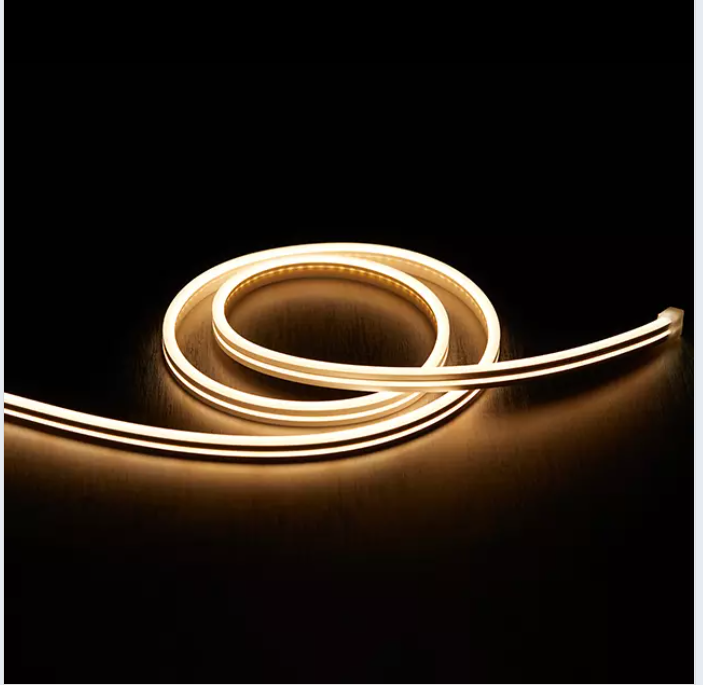Views: 0 Author: Site Editor Publish Time: 2025-05-15 Origin: Site
Ever seen your wall paint or clothes look weird under certain lights? That's probably a low CRI at work. CRI affects how true colors look. It can make your home feel bright or dull. In this post, you'll learn what CRI means, why it matters, and which CRI is best for LED strips.
Have you ever noticed colors looking dull or strange under some lights? That's likely because of a low CRI.
CRI stands for Color Rendering Index. It measures how well a light shows the true colors of objects.
● It uses a scale from 0 to 100.
● 100 CRI means colors look exactly like they do in sunlight.
● 80+ CRI is decent for most rooms.
● 90+ CRI is ideal when color accuracy matters.
CRI Score | Color Accuracy | Suitable For |
90–100 | Excellent – True color | Art, photography, retail, kitchens |
80–89 | Good – Natural look | Living rooms, offices, general use |
Below 80 | Poor – Washed out | Warehouses, parking, basic lighting |
A light can be bright but still make things look off. That's because CRI affects color appearance, not just brightness.
Example:
LED strip lights are used to highlight details—on walls, in kitchens, on art, and even in makeup mirrors.
If the CRI is low, your design or product can look faded or fake.
High CRI LED strips help colors stay true and vibrant in any space.Use them where color accuracy counts—like near skin tones, fabrics, or food.
CRI, or Color Rendering Index, tells us how well a light shows true colors. It's not about brightness—it's about accuracy.
CRI is scored from 0 to 100.
100 means perfect color accuracy, just like sunlight.
80+ is acceptable for general spaces.
90+ is preferred when color matters.
CRI Score | Color Appearance |
95–100 | Excellent – True-to-life |
90–94 | Great – Near-natural |
80–89 | Decent – Minor distortion |
Below 80 | Poor – Washed out colors |
CRI is not just one number. It's made up of 15 “R” values, each testing how a light shows specific colors.
● R1–R8: Pastel tones used for the basic CRI average (Ra).
● R9: Deep red (very important for skin tones, fruit, clothing).
● R12: Saturated blue.
● R13–R15: Skin and natural tones.
R Value | What It Represents | Why It Matters |
R1–R8 | Pastel colors | Basis for CRI Ra |
R9 | Strong red | Skin, meat, fabrics |
R12 | Deep blue | Sky, water, art |
R13–R15 | Complex natural tones | Wood, skin, plants |
Most LED lights fail to render deep reds well.
R9 is critical for accurate skin tones, food, and red fabrics.
● CRI Ra: Average of R1–R8. Common on spec sheets.
● Full spectrum CRI: Includes R9–R15, giving a full color picture.
So, a light might say “CRI 90” but still look off if R9 or R12 is low.
Always check full R-values when true color matters.

If you want colors to look vivid and natural, CRI matters more than you think.
Here's a simple guide:
● CRI 80–89: Good, okay for general lighting
● CRI 90–94: Excellent, colors appear more accurate
● CRI 95–99: Near perfect, ideal for color-critical work
CRI Range | Color Accuracy | Best For |
95–99 | Ultra-accurate | Art, film, museums, high-end retail |
90–94 | Very good | Homes, kitchens, offices, salons |
80–89 | Acceptable | Warehouses, hallways, utility lighting |
Some LED strips now reach CRI 99, which is almost identical to natural sunlight.
Top performers:
● ABSOLUTE™ Series by Waveform Lighting
● CRI 99, with excellent R9 and full-spectrum renderingNichia Optisolis Series
Full spectrum white light, engineered for ultra-high fidelityThese strips reveal subtle tones, skin colors, and reds without distortion.
Go with CRI 95+ if:
● You're shooting photos or video
● You work with paints, fabrics, or skin tones
● You need museum or gallery lighting
Use CRI 85–90 if:
● You just want cozy home lighting
● You're lighting storage or office areas
● Color fidelity isn't a major concern
Higher CRI may cost more or use more energy, but for accurate visuals, it's worth it.

CRI is helpful, but it doesn't tell the whole story. That's where R9, TM-30, and CQS come in.
R9 measures how well a light shows strong reds—like tomatoes, skin tones, or red fabrics.
● Many LED lights skip red to boost efficiency.
● Without red, faces and food can look pale or gray.
● High R9 (above 80) means richer, more natural color.
CRI Score | R9 Score | Color Quality |
90+ | 80+ | Excellent reds, lifelike skin tones |
90+ | <50 | Washed out reds, flat appearance |
Always look at R9 when lighting people, food, or warm-colored décor.
TM-30-20 is a modern color test with more depth than CRI.
It uses 99 color samples, compared to CRI's 8.
It gives two key values:
● Rf (Fidelity Index): How accurately colors match a natural source
● Rg (Gamut Index): How saturated or dull those colors appear
Metric | Range | What It Means |
Rf | 0–100 | Higher = more accurate color match |
Rg | 0–140 | 100 = neutral; <100 = dull, >100 = vibrant |
TM-30 also includes Color Vector Graphs that show hue shifts and saturation in 16 color zones.
CQS stands for Color Quality Scale, made to fix flaws in CRI.
● It uses 15 saturated colors instead of 8 pastels.
● Designed to match human visual preference, not just lab results.
● Better for evaluating rich, bold colors like deep blues, oranges, and purples.
System | Color Samples | Focus |
CRI | 8 (R1–R8) | Accuracy vs sunlight |
CQS | 15 saturated | Visual appeal + accuracy |
CRI only averages pastel shades (R1–R8). It ignores saturated tones, reds, and hues we see every day.
Professionals often use CRI + R9 + TM-30 together to choose lighting.
If you're lighting art, film, faces, or food—don't rely on CRI alone. Check those extra values to be sure.
Color Rendering Index isn't just numbers—it changes how things look and feel in everyday spaces.
● Under high CRI (95+) lighting, colors appear vivid and natural.
● Under low CRI (<80), colors can look gray, dull, or even misleading.
CRI Level | Appearance | Visual Effect |
95–100 | True-to-life, accurate colors | Rich tones, crisp textures |
80–89 | Slightly off, somewhat faded | Acceptable for general lighting |
<80 | Muted, washed out, distorted | Poor skin tone and product visibility |
1. Red Apple
● High CRI: Deep, rich red with clear surface texture
● Low CRI: Orange-brown hue, flat appearance
2. Skin Tones
● High CRI: Natural warmth, healthy glow
● Low CRI: Washed out, sickly or gray
3. Paintings & Art
● High CRI: Every brushstroke and shade pops
● Low CRI: Colors blend or fade into each other
Retail Displays
● High CRI lighting makes products look more appealing.
● Clothing, jewelry, and makeup show true color—boosting customer confidence.
Kitchens
● With CRI 95+, food colors are vibrant and fresh.
● It helps when cooking, plating meals, or showing off finishes.
Salons & Barbershops
● Accurate color is key for skin, hair, and makeup.
● CRI below 85 may make clients look pale or unnatural.
Environment | Recommended CRI | Why It Matters |
Retail | 90+ | Better product appeal, more sales |
Kitchen | 90–95 | Food looks fresh and appetizing |
Beauty/Salon | 90–95 | Natural skin and hair tone accuracy |
Art Studio | 95–100 | True-to-life color in fine detail |
Finding the right LED strip isn't just about brightness. CRI, R9, and other specs matter, especially when color accuracy is key.
Ask yourself: What's this light for?
● Task lighting: Kitchen, workbench, bathroom
● Ambiance: Living room, hallway, bedroom
● Display: Retail, art, product showcase
Each setting needs different CRI and brightness levels.
Choose based on how important color accuracy is:
Use Case | Minimum CRI | R9 Requirement |
General home | 80–90 | Not critical |
Photography | 95–99 | 80+ |
Retail/Makeup | 90–95 | 60+ |
Medical/Studio | 95+ | 90+ |
If skin tone, red tones, or fine color detail matters—prioritize R9.
CCT = Color Temperature, measured in Kelvin (K)
CCT (K) | Light Color | Best For |
2700K–3000K | Warm white | Cozy, relaxing spaces |
4000K | Neutral white | Balanced, natural lighting |
5000K–6500K | Cool white | Task, detail, clean look |
Brightness is measured in lumens per foot (or meter).
Higher CRI strips may have slightly lower lumen output—but look better overall.
4. Choose Strip Type
● SMD (Surface-Mounted Diode): Common, good value
● COB (Chip-On-Board): Uniform, dot-free light
● High-density: More LEDs per meter, smoother output
Strip Type | Advantages | Ideal For |
SMD | Affordable, flexible | General use |
COB | No hot spots, clean glow | Shelves, reflective areas |
High-Density | Bright, consistent | Work zones, photography |
High CRI strips may use more power, but modern tech balances that.
Look for LEDs with high lumens per watt (lm/W).Budget tip:
If full CRI 95+ isn't needed, a CRI 90 strip with good R9 can save money.
Before buying, check the spec sheet. Look for:
● CRI Ra and R9 values
● Spectral power distribution (SPD) chart
● TM-30 color vector graphs (if available)
Good manufacturers offer full photometric reports, not just marketing numbers.
These reports help you verify if a strip performs as claimed.
Match the CRI level to your project's needs. Most homes do well with CRI 90+.For art, film, or retail, choose CRI 95–99 with high R9. It's not just about brightness—choose lights that show true, natural colors.
A: Yes, when color accuracy matters. Bright lights can still distort colors if CRI is too low.
A: Not always. Check for full specs, R9 values, or independent photometric reports for accuracy.
A: CRI 95 shows more accurate reds and skin tones. CRI 90 is good, but not as color-true.
A: Likely due to low R9 or low CRI lighting, which weakens red tones.
A: No. RGB strips are for color effects, not accurate white light or color rendering.
INTEGRATE™ is a series of integrate flexible LED strips including single White, single Color, variable white, RGB, RGB pixel, RGBW and RGBVW. Various types would meet any your customized requirements. Integrate has dome surface as COB for soft and dot-less effect, same SMD technology as lighting sou
Flexible SMD LED strip lights have become one of the most popular lighting solutions in both residential and commercial environments. Their slim profile, low power consumption, and versatility make them suitable for accent lighting, task lighting, decorative installations, and even large-scale architectural illumination. Among the wide range of LED chips available today, SMD 3528 and SMD 5050 remain two of the most commonly used and widely recognized options.
SMD LED strip lights have become one of the most versatile and popular lighting solutions in modern homes, commercial environments, and creative projects. Their slim profile, flexible design, and energy efficiency make them ideal for accent lighting, task lighting, ambient illumination, and decorative installations. Yet one of the biggest questions users have—especially beginners—is whether SMD LED strip lights can be cut without damaging them.
LED strip lighting has become one of the most versatile and widely adopted solutions for modern residential, commercial, and architectural lighting. Among the different types of LED strips available today, SMD LED strip lights and COB LED strips are the two most popular choices. Each offers unique advantages, performance characteristics, and visual effects, making them suitable for different applications.
SMD LED strip lights have become one of the most versatile and widely used lighting solutions for residential, commercial, and industrial applications. From accent lighting in living rooms to large architectural installations and retail displays, LED strips offer flexibility, efficiency, and precise illumination control. However, managing long LED strips—especially those stretching beyond 5–10 meters—comes with unique challenges.
LED lighting has revolutionized the way homes, commercial spaces, and decorative environments are illuminated. Among the most popular modern lighting solutions, LED flexible strip lights stand out because they combine versatility, energy efficiency, and sleek aesthetics. Within this category, SMD LED strip lights have become the industry standard due to their compact size, strong brightness, and adaptability to a wide range of applications.
In the world of modern lighting, few products have transformed interior and exterior illumination as dramatically as SMD LED strip lights. Whether used for home decoration, retail ambiance, architectural highlights, or industrial applications, these flexible and efficient lighting tools offer unparalleled versatility. Their slim design, excellent brightness, and wide color options have made SMD LED strips a preferred choice for designers, homeowners, and engineers alike.
Light and color have long been understood to influence human emotions, behavior, and even physical well-being. From the moment we wake up to the time we go to sleep, the type of light surrounding us plays a vital role in shaping our moods, productivity, and overall state of mind. This is why understanding the psychology of light and color is crucial when selecting LED lighting for various environments, whether it's at home, in the office, or in commercial settings.
LED strip lights are a popular choice for modern lighting due to their energy efficiency, versatility, and sleek design. However, one crucial aspect that is often overlooked when using LED strips is thermal management. LED lights, like any other electronic component, generate heat as they operate, and if not properly managed, this heat can reduce their performance and lifespan.
Choosing the right LED strip lights for your home or office is a decision that requires careful consideration. LED strips have become an increasingly popular choice due to their versatility, energy efficiency, and aesthetic appeal. However, with so many options available on the market, it’s easy to feel overwhelmed by the number of different types and features.
Indirect lighting has become a popular choice for creating a soothing and stylish ambiance in both residential and commercial spaces. Unlike direct lighting, which often creates harsh shadows and bright spots, indirect lighting provides a more gentle and even illumination that enhances the atmosphere without overwhelming the eyes.
Proper lighting on boats or yachts is not just about enhancing the aesthetic appeal; it plays a crucial role in ensuring safety, functionality, and comfort on the water. Effective lighting can help improve visibility during nighttime navigation, set the mood for evening activities, and highlight specific areas of your vessel. One of the best lighting options for marine environments is LED strip lights. Their versatility, energy efficiency, and durability make them an excellent choice for a variety of marine applications.
To ensure that your LED strip lights continue to perform at their best and last as long as possible, proper care and installation are essential. LED strips are known for their longevity and energy efficiency, but several factors can influence how long they last. By following some simple yet effective maintenance tips, you can extend the lifespan of your LED strips and keep them running smoothly for years to come.
When purchasing LED strip lights for your home or business, you might notice various certifications listed on the product packaging or technical specifications. These certifications, often represented by logos or marks, indicate that the product has met specific safety, environmental, and quality standards. Understanding what these certifications mean can help you make informed decisions, ensuring you choose a reliable and safe lighting solution.
LED strip lights are a fantastic way to add vibrant lighting to your home or workspace, offering versatility and energy efficiency. However, when it comes to installation, there are common mistakes that many people make, which can negatively affect the performance, lifespan, and overall functionality of the LED strips. Whether you're a seasoned DIYer or a first-time installer, it's crucial to avoid these common errors to ensure your LED lights shine brightly and last for years to come.
Flexible lighting strips, commonly known as LED strips or tape lights, have revolutionized the way we illuminate spaces. Their adaptability, energy efficiency, and vibrant lighting options make them popular choices for a wide variety of applications—from home decor to commercial advertising and industrial uses.
In recent years, flexible lighting strips have become increasingly popular not just for indoor use, but also as a creative and practical solution for outdoor lighting applications.
Flexible LED strip lights have rapidly gained popularity in both residential and commercial lighting applications. Their versatility, energy efficiency, and ease of installation make them an excellent choice for accent lighting, decorative purposes, and practical illumination alike.
Flexible lighting strips, commonly known as LED strip lights, are thin, versatile lighting fixtures that consist of small light-emitting diodes (LEDs) mounted on a flexible circuit board.
In the world of modern lighting, flexible lighting strips—also known as LED strip lights or ribbon lights—have revolutionized how we illuminate spaces. These thin, adaptable lighting solutions offer not only energy efficiency but also unmatched versatility, making them a top choice for a wide range of residential, commercial, and industrial applications.


